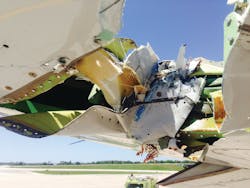When was the last time you traveled through an airport and have not seen some type of construction in progress? Whether it’s inside the terminal facility, runways, taxi ways, or the ramp and tarmac areas, congestion and the increased risks that airport construction brings into active airport operations needs to be properly managed to prevent aircraft ground damages.
Airport real estate is often at a premium as airports try and maximize ramp and tarmac space to accommodate increasingly larger aircraft and their footprints on the ground. For example, aircraft with “winglet” features, fresh out of the factory or retrofitted, adds additional length and height to the wings increasing the profile (wing growth) of the aircraft.
Eliminating aircraft ground damages caused by aircraft being struck by other aircraft and the wingtip clearances between moving and parked aircraft needs to be actively monitored in tight operating areas at any airport.
When marshaling aircraft into gate spaces, pushing aircraft onto taxiways and repositioning aircraft from hangars and remote parking locations, constant and accurate communication will be one of the most effective means of reducing risk and eliminating hazards that are associated with this important ramp function.
Something as simple as an aircraft pre-movement “huddle” with the ground repositioning teams and ground operations teams can be effective if conducted properly; this promotes organization and continuity within the team as each team member will understand their role and responsibility during aircraft movement. Hazards and obstacles can be identified prior to aircraft movement with strategies already in place to eliminate and reduce risks and avoid hazards during the aircraft movement process.
“What if” planning eliminates making a mistake that you didn’t necessarily intend to commit. However, when faced with something that is “out of the norm,” such as airport construction, our normal decision-making process is challenged and bad decision-making often leads to a mistake that can lead to aircraft damage or an employee injury.
NOT JUST THE GATE
Handling aircraft is much more than loading and unloading, servicing and cleaning at the gate.
Moving aircraft in less than ideal situations, such as during airport construction, requires organization and management. An effective aircraft movement team will have identified responsibilities throughout the team reducing ambiguity between members.
This will foster alignment of all responsibilities throughout the team with each team member aware of a preventative strategy and aircraft movement team members will be aware of and have more clarity of specific responsibilities during the movement process.
Something as simple as accurate and effective communication, and holding team members accountable for their responsibilities in the aircraft movement process is one approach to “change management.” A plan such as this can easily be implemented and assessed for effectiveness.
BEFOREHAND
Prior to any airport construction project, adequately evaluating risk at the gates, on taxiways and in aircraft maintenance hangars (all aircraft movement areas), can be accomplished by conducting risk assessments for these areas.
It is an important task that air carriers need to accomplish to reduce the probability of an event occurring where the wing of an aircraft comes in contact with stationary objects such as a boarding bridge or other aircraft wing tips from adjacent gates and hardstand areas.
When conducting a gate risk assessment, step back and envision; “WHAT can go wrong? WHAT can happen?”
Use your experience, expertise and knowledge of local airport configurations and regulations to ask these questions when there are differences in airport layouts due to construction or re-configuration. Communication and risk assessments are two important components of “change management.”
When conducting an assessment on your operation, especially gate, taxiway and tarmac areas that may undergo a construction project, there are several hazards that should be addressed prior to the start of any project that will alter normal, everyday operations.
The following hazard questions can be considered a checklist, but in reality should be considered more of a memory jogger of what we should be asking ourselves:
- Am I identifying and documenting all hazards that exist?
- Who is at risk and how may harm occur?
- What am I already doing? (list any existing control measures, procedures, or safeguards that already exist)
- Have risks been reduced “as far as reasonably possible”? (If not, state what additional measures should be considered.)
RISK RATING
Assigning a risk rating based on probability and severity can be accomplished by using a simple risk matrix that will determine a risk rating based on these two variables. It is also important to assign a responsible person within the organization to communicate the identified hazards and risks.
The use of wireless headsets is an example of technology that will greatly reduce aircraft collisions while under the control of ground crews.
The wireless headsets provide a better way to communicate in ramp operations because it allows communication in both directions between the pushback driver and the wing walkers (or other employees wearing them) to speak in real time, unlike a standard handheld walkie-talkie. The wing walkers can also hear the communication between the flight deck and the pushback operator allowing the entire team to be focused on the task at hand; in this case, moving aircraft throughout congested aircraft landscape due to reconfiguration from construction.
When moving aircraft, hand signals are greatly relied upon. But hand signals only work when they can be seen and are effective if they are executed in a clear, concise manner by the person who is giving them.
In most cases, we see personal “interpretation” of hand signals, or ineffective variations of standard hand signals that often lead to undesirable outcomes.
With a wireless headset product, the pushback driver can literally be right in the ears and mind of the wing walkers and aircraft marshallers by eliminating self-induced and external distractions, and reducing channelized attention and tunnel vision from ground employees that are given the task of assisting with aircraft movement and repositioning. Aircraft collisions between a fixed object and other aircraft have been avoided and documented by aircraft repositioning crews wearing wireless headsets throughout the industry.
Maintaining situational awareness of aircraft wingtip and tail clearances for specific operational areas, such as airport construction zones, performing continual risk assessments until the work is completed; teamwork and technology can assist with aircraft damage prevention strategies at our ever-changing airport landscapes.
About the author: Kevin P. Crowley, senior analyst for ground safety programs, CQA/ASQ, JetBlue Airways Corp., started on the ramp in Buffalo, NY, in 1993. He's been with JetBlue for 12 years and began as an instructor at JetBlue University and taught aircraft servicing for the A320 and E190. He has additional experience in HAZMAT and dangerous goods; winter ops and deicing; and is a certified OSHA instructor.




